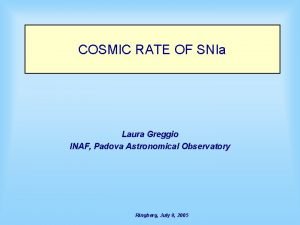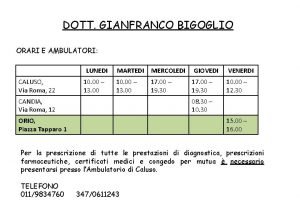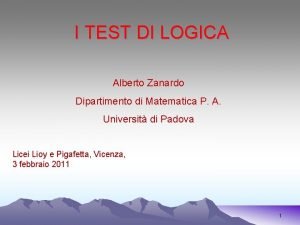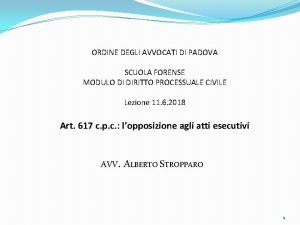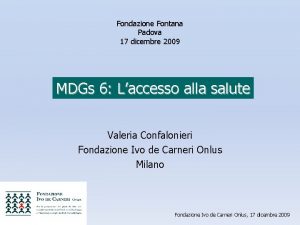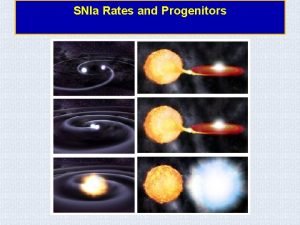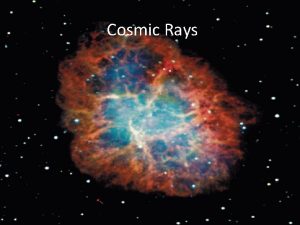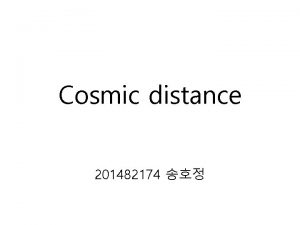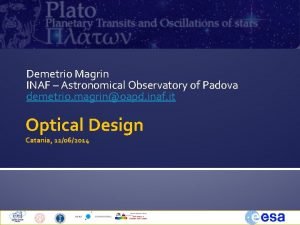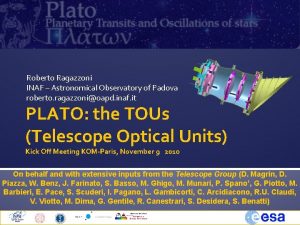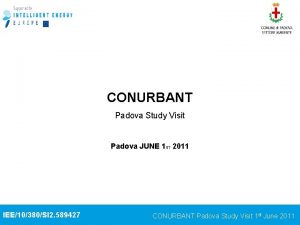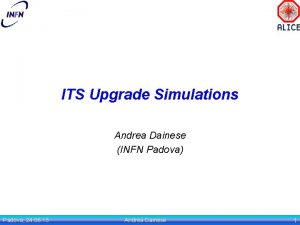COSMIC RATE OF SNIa Laura Greggio INAF Padova















- Slides: 15

COSMIC RATE OF SNIa Laura Greggio INAF, Padova Astronomical Observatory Ringberg, July 8, 2005

SNIa are relevant to the study of: v v Chemical evolution of galaxies Chemical evolution of the ICM and IGM Gas flows in Ellipticals The determination of cosmological parameters To study # 1, 2 and 3 we need the SNIa rate following a burst of SF To address # 4 we need to understand the nature of the SNIa progenitor The cosmic evolution of the SNIa rate helps constraining both Ringberg, July 8, 2005

Dahlen et al. 2004: SNII trace the recent SF use the rate of type II to trace the cosmic SFR SNIa come from longer lived progenitors: At a cosmic epoch t the SNIa rate is • τ is the delay time (interval between the birth of the stellar system and its explosion) • f. Ia is the distribution function of the delay times • AIa is the realization probability of the SNIa event out of one stellar generation • kα is the number of stars per unit Mass of one stellar generation Ringberg, July 8, 2005

(1984) Close Binary Evolution provides two main cathegories of SNIa precursors: Single Degenerate Systems a CO WD accretes from a living companion Double Degenerate Systems the companion is another WD Explosion may occur when • the WD mass reaches the Chandrasekhar limit (Ch-exploders) SD DD • a Helium layer of ≈0. 1 MO, accumulated on top of the WD, detonates (Sub-Ch exploders) Ringberg, July 8, 2005

Pros and Cons Single Degenerates: Double Degenerates: Candidate precursors observed (SSXRS, Symbiotic, CV) Absence of H in the spectra Fine tuning of accretion rate is needed to avoid nova and/or CE (small volume in the phase space) Theoretical likelyhood accounts for current rate in the MW Theoretical explosion leads to neutron star Absence of H in the spectra Observed DDs are not massive enough CHANDRA exploders : uniform light curves and better spectra BUT few of them SUB-CHANDRA : many of them BUT variety of Ni 56 produced and high velocity of ejected Ni Ringberg, July 8, 2005

Population Synthesis of Binaries Monte Carlo simulations of a population of binaries with n(m 1), n(q), n(A 0), following the evolution of each system through the RLOs and determining the outcome (CVs, RCBor, sd. O, all varieties of DD. . , sometimes SNIa) Tutukov & Yungelson , Ruiz-Lapuente, Burket & Canal, Han et al. , Nelemans et al. Yungelson and Livio 2000 The results are: (highly) model dependent ( a. CE, mass loss, criterion for mass transfer stability …) hard to implement in other computations (for galaxy evolution, cosmic evolution…) BUT the distribution function of the delay times can be characterized on general grounds … Ringberg, July 8, 2005

Single Degenerates: Clock is the nuclear timescale of the secondary Evolutionary clock and Distribution of the secondaries in systems which give rise to a SNIa + limits on primary mass: Ringberg, July 8, 2005

Double Degenerates Clock is the nuclear timescale of the secondary + the gravitational delay Double CO WDs: m 1, m 2 2 then tn≤ 1 Gyr MDD=2 τgw ranges in 5 Myr – 15 Gyr A ranges from 0. 5 to 3. 8 Ro The distribution function of the separations of the DD systems is crucial for the distribution of the gravitational delays Shrinkage at RLO: • Start from: 100 R 0 <A 0 < 1000 R 0 • Go through RLO: standard CE: (A/AO)≈few 10 -3 heavier systems have smaller A/AO & shorter tgw Nelemans et al. : large range of (A/AO) no correlation between mass and tgw A small dispersion in DD masses and/or final separations yield a wide distribution of delay times Ringberg, July 8, 2005 WIDE DDs CLOSE DDs

The distribution function of the delay times for DDs mainly controlled by: maximum nuclear delay (minimum m 2 of a successful system) whether evolution leads to WIDE or CLOSE DD distribution function of the separations of the DD whether favouring larger or smaller A Ringberg, July 8, 2005

The distribution function of the delay times All models normalized at 12 Gyr : Main Parameters : SD: minimum mass of the primary for a successful SNIa (distribution of mass ratios) DD: 1) minimum mass of the secondary (fix maximum nuclear delay) 2) distribution function of the separations after II RLO 3) whether WIDE or CLOSE Different models have: • different Fe production Ringberg, July 8, 2005

The Cosmic SNIa rate Ringberg, July 8, 2005

Results of the convolution: The results of the convolution are rather sensitive to the adopted cosmic SFR: A steep increase from z=0 to 1 favors a steep increase of the cosmic SNIa rate A decrease from z=1 upward Could explain the low SNIa rate at z=1. 6 Ringberg, July 8, 2005

SNIa rate in different galaxy types Another way to constrain the distribution function of the delay times • Younger stellar populations sample the peak of the distribution function of the delay times • Younger stellar populations are bluer Bluer galaxies have larger SPECIFIC SNIa rates Ringberg, July 8, 2005 Data from Mannucci et al. 2005

CONCLUSIONS Ø I illustrated how the SFR and the distribution function of the delay times compose to determine the SNIa rate in galaxies The current SNIa rate in Spirals mostly constrains the realization probability of the SNIa scenario; in Ellipticals it scales as the f. Ia function The ratio between the current SNIa rates in Spirals and Ellipticals constrains the shape of the function Ø I presented analytic expressions, describing the distribution function of the delay times for Single and Double Degenerate progenitors These expressions are based on general stellar evolution arguments, which result into a f. Ia function controlled by a few main parameters Ø Representing Es as instantaneous burst of SF, and using their current rate to calibrate the f. Ia function, I showed that: SD models and greatly overproduce Fe in Galaxy Clusters overpredict the current rate in Spiral galaxies The data are met with either or CLOSE DDs with flat n(A) WIDE DDs with steep n(A) Ringberg, July 8, 2005

NORMALIZATION Horizontal levels derived from rate in galaxies Points derived from cosmic rate Ringberg, July 8, 2005
